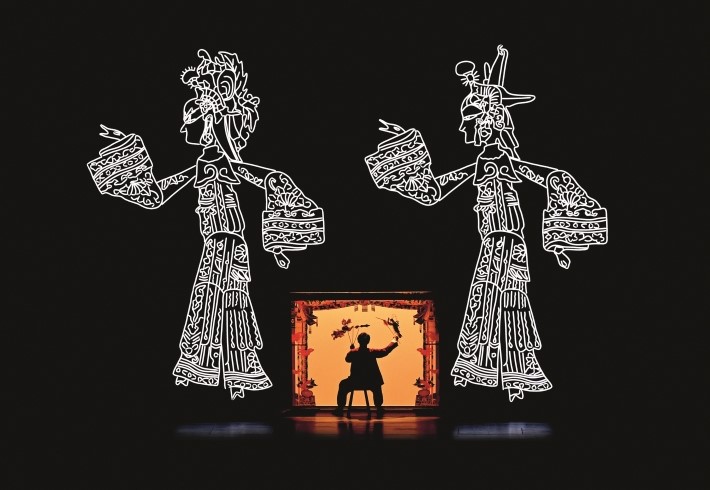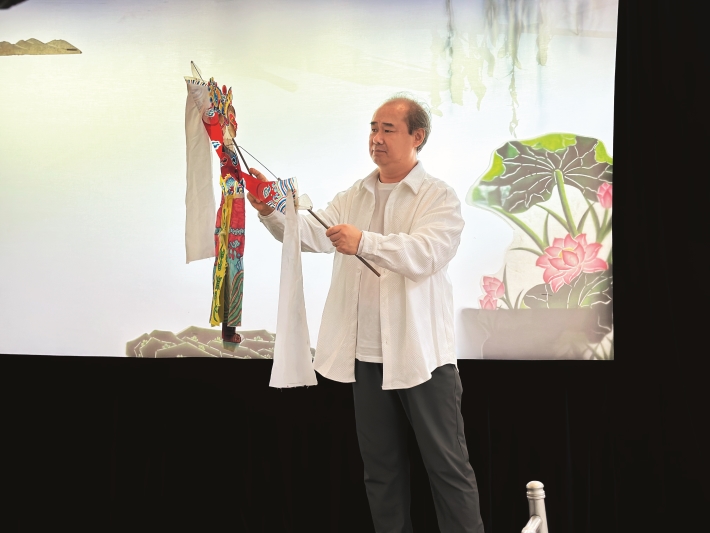|
||||||||||
| Home Nation World Business Opinion Lifestyle ChinAfrica Multimedia Columnists Documents Special Reports |
|
||||||||||
| Home Nation World Business Opinion Lifestyle ChinAfrica Multimedia Columnists Documents Special Reports |
| ChinAfrica |
| A Tale of Light and Shadow |
| Chinese shadow puppetry seeks to explore new avenues |
| By Ge Lijun | VOL. 16 May 2024 ·2024-05-23 |

Shadow puppetry fuses Chinese shadow theatre with the technique of visual projection (XINHUA)
Accompanied by music, a turtle and a crane fight in a humorous story created by the simple interplay of light and curtain. This Chinese shadow puppetry performance makes the audience laugh. Backstage, Lu Baogang, a national-level inheritor of Beijing shadow puppetry art, and the other performers of the shadow puppetry troupe manipulate the silhouettes with great skill.
In this room, the crane performs a series of complex movements that are particularly difficult to handle. Having taken over from his father at the age of 15, Lu once spent hours at the zoo watching the cranes. At the age of 60, Lu, who is also the director of the Beijing Shadow Show Troupe, already has more than 40 years of experience in the art of shadow puppetry.
Chinese shadow puppetry, which combines the principles of light and shadow with the arts of drawing and singing, took shape in the Western Han Dynasty (206 B.C.-A.D. 8), reached its peak in the Tang (618-907) and Song (960-1279) dynasties, and spread as far as Europe and Western Asia during the Yuan Dynasty (1271-1368). Inscribed on UNESCO’s Representative List of the Intangible Cultural Heritage of Humanity in 2011, Chinese shadow puppetry is now facing the challenges posed by contemporary entertainment. Lu and other inheritors of this art from across China are seeking to reinvigorate the age-old tradition by exploring new avenues, attracting attention and appreciation for their quest for renewal.

Lu Baogang presents a Chinese shadow puppet (COURTESY)
Innovative development
Over the years, the number of spectators for Chinese shadow puppetry has declined. For artists of Lu’s generation, finding new ways to innovate is therefore a crucial challenge. He has long been aware that traditional shadow puppetry does not enjoy great success in the marketplace, being less popular than other art forms. That’s why his company has begun to explore inter-theatre fusion.
“This fusion involves combining shadow puppetry with other theatrical forms such as spoken theatre, musical comedy and puppet theatre. This is being done in order to address certain gaps in our art, such as its flat, two-dimensional nature,” Lu told ChinAfrica. Although this specificity is a strength, it can also be a weakness in terms of visual impact. Therefore, artists are seeking to remedy this by integrating other theatrical forms that are more attractive on stage, instead of a simple curtain, he added.
The first experiment began in 2015. At a shadow puppetry competition, Lu won the Creativity Award with his play The Legend of Meng Jiangnu, a classic tale combining human and puppetry performances. This success encouraged him in innovating the art form.
Building on this approach, Lu’s troupe has produced two highly acclaimed plays: In 2019, The Legend of the Shadows was created, followed by The Shadow Box’s Fantastic Journey in 2023. These productions combine shadow puppetry with various techniques and forms of expression, including human shadows, paper silhouettes, and shadow landscapes. They also explore innovative concepts in set design, music, and staging. “Our objective with these two plays was to attract a younger audience,” Lu noted while highlighting that the plays have received positive reviews.
Other shadow puppetry troupes across the country are also innovating. Wang Haiyan, a representative inheritor of shadow play in Shaanxi Province, is incorporating elements from cartoons and video games into her contemporary puppets. Wang was inspired to create new shadow puppets by a cartoon festival she visited with her son a few years ago. She has merged tradition and modernity in her designs.
She has also engaged in active “cross-sector” cooperation with clothing, automotive, fashion and other brands.

A scene from the play The Tortoise and the Crane (GE LIJUN)
Contribution of digital technology
As modern society undergoes transformation, digital technology offers invaluable opportunities and resources for shadow puppetry, opening up new artistic perspectives. Aware of the appeal of immersive experiences such as 4D films, Liu Chaokan, a representative inheritor of shadow play in Yunnan Province, has decided to incorporate 4D elements into its performances. This represents a significant development in the field of shadow puppetry, as it marks the first instance of traditional shadows being combined with holographic projection technology on a modern stage. This is exemplified by the shadow play The Memories of Tengchong, which offers spectators a distinctive immersive experience. “We must not deny our traditions, but enrich them with new elements so that shadow puppetry continues to be appreciated in our times,” said Liu.
In the context of the current media landscape, the shadow puppetry troupe in Haining, Zhejiang Province, makes extensive use of the Internet to promote itself. Liu Fan, a young performer, regularly produces short videos and posts them online, revealing behind-the-scenes information and techniques. His videos are very popular on social media platforms. This year, new promotional plans are already under way.
The Beijing Shadow Show Troupe, where Lu Baogang works, also recognises the importance of the Internet. It has already collaborated with major Chinese Internet and tech platforms such as Bilibili and NetEase. The results of these collaborations have been highly beneficial. For instance, to promote a video game on Bilibili, they produced a promotional video featuring shadow puppetry, which attracted a considerable audience.
Despite his impending retirement in October, Lu has no intention of giving up his role in maintaining the art form’s survival. He said that pursuing innovative developments remains a priority. “The art of shadow puppetry is deeply rooted in our popular culture, and I am committed to perpetuating it. Nothing and no one can stop me, because that is the task of the inheritors.” he added.
Chinese Shadow Puppetry
Chinese shadow puppetry is a form of theatre acted by colourful silhouette figures made from leather or paper, accompanied by music and singing. Manipulated by puppeteers using rods, the figures create the illusion of moving images on a translucent cloth screen illuminated from behind. The relevant skills are handed down in families, in troupes, and from master to pupil. Chinese shadow puppetry also passes on information such as cultural history, social beliefs, oral traditions and local customs. It spreads knowledge, promotes cultural values and entertains the community, especially the youth.
| About Us | Contact Us | Advertise with Us | Subscribe |
| Copyright Beijing Review All rights reserved 京ICP备08005356号-5 京公网安备110102005860号 |